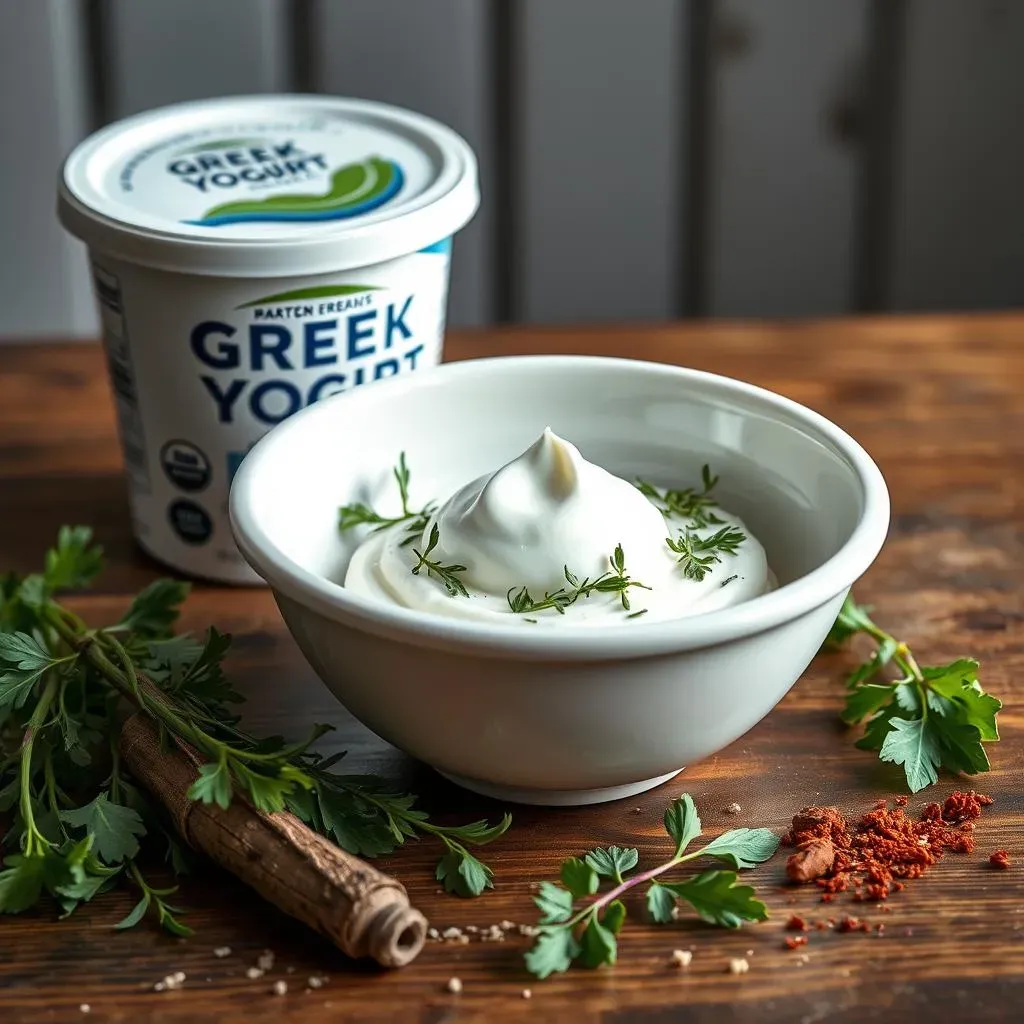Table of Contents
Ever stared into your fridge, craving that creamy tang of sour cream, only to find an empty container? Don't panic! Greek yogurt is here to save the day, and your dish. It's not just a healthy swap, it's a flavor powerhouse ready to take on the role of its richer cousin. This article is your guide on how to substitute greek yogurt for sour cream, whether you're aiming to cut calories, boost protein, or simply need a quick fix. We'll explore why this substitution works so well, what types of Greek yogurt are best, and how to use it in various recipes, from dips to baked goods. Plus, we'll tackle the big question: how do you make Greek yogurt taste just like sour cream? Get ready to unlock a world of creamy goodness with this simple yet game-changing swap!
Why Substitute Greek Yogurt for Sour Cream?

Why Substitute Greek Yogurt for Sour Cream?
Healthier Choice
Let's be real, sour cream is tasty, but it's not exactly a health food. It's high in fat and calories, which isn't ideal if you're watching your intake. Greek yogurt, on the other hand, is like the superhero of the dairy aisle. It's packed with protein, which is great for keeping you full and building muscle. Plus, it's lower in fat and calories than sour cream, making it a smart swap for anyone looking to make healthier choices without sacrificing flavor. I mean, who wouldn't want a creamy topping that's actually good for you?
Consider this: a dollop of sour cream might make you feel a bit sluggish later, while the same amount of Greek yogurt will keep you going. It's like trading in a gas-guzzling car for a sleek, efficient hybrid. You get the same satisfying experience, but with a much smaller impact.
Nutritional Benefits
Beyond the lower fat and calorie count, Greek yogurt brings a whole squad of nutritional benefits to the table. It's a fantastic source of calcium, which is crucial for strong bones and teeth. It also contains probiotics, which are beneficial bacteria that can help improve your gut health. A happy gut means better digestion and a stronger immune system. Think of it as a little army of good guys working inside you. Sour cream? Well, it doesn't have that kind of backup.
So, when you reach for Greek yogurt instead of sour cream, you're not just making a swap; you're upgrading your meal with extra nutrients. It’s like choosing a multi-vitamin over a sugary candy – both might satisfy the craving, but one nourishes your body while the other just gives you a quick sugar rush. It's a no-brainer if you ask me.
Nutrient | Greek Yogurt (1 cup) | Sour Cream (1 cup) |
|---|---|---|
Calories | ~130-220 | ~440 |
Protein | ~20-25g | ~7g |
Fat | ~0-10g | ~40g |
Calcium | ~20% DV | ~10% DV |
Probiotics | Present | Absent |
Versatility and Taste
Okay, let's talk about taste and versatility. Greek yogurt is surprisingly adaptable. It has a tangy flavor that's similar to sour cream, but it's also a bit more subtle. This means it can easily take on the flavors of whatever you pair it with. You can use it as a base for dips, a topping for tacos, or even in baking. It plays well with others, unlike some ingredients that insist on being the star of the show. Plus, you can easily adjust the taste by adding a squeeze of lemon juice or a dash of vinegar to mimic that extra tang of sour cream.
So, whether you're looking for a healthier alternative or just a versatile ingredient, Greek yogurt is a great option. It’s like having a chameleon in your kitchen, ready to transform into whatever you need it to be. And honestly, who doesn't appreciate a good multi-tasker? I know I do.
The Best Type of Greek Yogurt for Sour Cream Substitutes

The Best Type of Greek Yogurt for Sour Cream Substitutes
Full-Fat Greek Yogurt: The Gold Standard
Okay, so you're ready to ditch the sour cream and embrace the Greek yogurt life? Smart move. But not all Greek yogurts are created equal, especially when it comes to mimicking that rich, tangy flavor and texture of sour cream. The absolute best choice? Full-fat Greek yogurt. I'm not kidding; it's the gold standard. Think of it like this: if sour cream is a decadent dessert, full-fat Greek yogurt is a slightly less rich but equally satisfying treat. It's got that creamy mouthfeel and that slight tang that sour cream lovers crave. It’s the closest you’ll get to the real deal, without all the extra baggage that comes with sour cream.
When you're staring down the yogurt aisle, don't be afraid of the full-fat option. It's not going to derail your healthy eating plans, and it'll make your recipes taste way better. Trust me, that extra bit of fat is what gives it the richness needed to stand in for sour cream. It's like choosing a good quality olive oil over a cheap vegetable oil – the difference is in the flavor and texture. You want that smooth, creamy consistency that full-fat Greek yogurt provides.
Why Not Low-Fat or Non-Fat?
Now, you might be thinking, "Okay, but what about low-fat or non-fat Greek yogurt? They're healthier, right?" Well, yes and no. They're lower in fat and calories, which can be a plus, but they often lack the richness and creamy texture you need to effectively replace sour cream. They can also have a slightly different flavor profile, sometimes a bit more watery or even chalky, which isn't what you're after. It's like trying to paint a masterpiece with diluted paint; it just doesn't have the same impact.
Think of it like this: full-fat Greek yogurt is like a well-made leather jacket - it's durable, comfortable, and looks good. Low-fat or non-fat versions are like those cheap imitations that might look similar at first glance but don't have the same quality or feel. If you’re really in a pinch, you can try straining low-fat or non-fat greek yogurt to remove some of the excess liquid, but it still won’t be quite the same.
Type of Greek Yogurt | Texture | Flavor | Best for Sour Cream Substitute? |
|---|---|---|---|
Full-Fat | Rich, creamy | Tangy, slightly sweet | Excellent |
Low-Fat | Lighter, can be watery | Tangy, less rich | Good, but may need straining |
Non-Fat | Thin, can be chalky | Tangy, less rich | Not ideal |
The Straining Option
Okay, let’s say you’ve only got low-fat Greek yogurt on hand, or maybe you just want to get the texture even closer to sour cream. Don’t worry, there’s a trick: straining. By removing some of the excess whey, you can thicken up your yogurt and make it even more like sour cream. It's a bit like turning a regular cotton t-shirt into a thicker, more substantial one. You can do this by lining a fine-mesh sieve with cheesecloth or a coffee filter, placing the yogurt in the sieve, and letting it sit in the fridge for a few hours. The longer it sits, the thicker it will get. I've done this many times, and it really makes a difference.
So, while full-fat Greek yogurt is the ideal choice, don’t throw out your low-fat stuff just yet. With a little patience and some basic kitchen tools, you can make it work. It’s like being able to fix a flat tire on your bike – it’s not ideal, but it gets you back on the road. And sometimes, that’s all you need. Remember, the goal is to get that creamy texture and tangy taste that makes a great sour cream substitute.
How to Use Greek Yogurt Instead of Sour Cream in Recipes

How to Use Greek Yogurt Instead of Sour Cream in Recipes
Alright, so you’re armed with the best Greek yogurt for the job, now let’s get to the fun part: actually using it. The good news is, swapping Greek yogurt for sour cream is usually a pretty straightforward process. For most recipes, you can do a straight one-to-one substitution. That means if the recipe calls for one cup of sour cream, you use one cup of Greek yogurt. It’s as simple as that. Think of it like swapping out one type of fuel for another in a car—it mostly works the same, just with a few minor differences. However, there are some nuances to be aware of, especially when it comes to baking and specific types of dishes, we'll get to that in a bit.
Now, before you go wild swapping sour cream in every single recipe you see, let's talk about what to expect. Greek yogurt has a tangier flavor than sour cream, which, honestly, I think is a good thing. But if you're going for a more subtle flavor, you can add a tiny pinch of sugar or a splash of milk to mellow it out. Also, because Greek yogurt has less fat than sour cream, it might not be quite as rich or creamy, especially in baking. This is where the full-fat version shines, as it helps to maintain that satisfying texture. It’s like choosing between a well-worn pair of jeans and a new pair – they both do the job, but one has a more comfortable and familiar feel. In the end, the goal is to make the swap seamless and delicious, not a downgrade.
Recipe Type | Substitution Notes | Example |
|---|---|---|
Dips | 1:1 swap. Add extra herbs/spices for flavor. | French Onion Dip |
Toppings | 1:1 swap. May need a touch of lemon for tang. | Tacos, Baked Potatoes |
Salad Dressings | 1:1 swap, adjust liquid for desired consistency. | Creamy Ranch Dressing |
Baking | Use full-fat. May need to reduce other liquids. | Cakes, Muffins |
Let’s get into some more specific scenarios. When it comes to dips and sauces, Greek yogurt is a total rockstar. It works wonderfully in creamy dips like spinach artichoke or ranch, and it can make your salad dressings extra tangy and delicious. Just be mindful that greek yogurt is a little thicker than sour cream, so you might need to add a touch of liquid, like milk or water, to get it to your desired consistency. It is like using a new kind of paint, you might need to adjust the amount of water to reach the right texture. For toppings like tacos and baked potatoes, it's a simple swap and the flavor difference is barely noticeable. Just add a bit of lemon juice if you want to boost that signature sour cream tang.
Now, baking is where things get a little trickier. Because Greek yogurt has less fat than sour cream, it can sometimes make your baked goods a bit denser. The key here is to use full-fat Greek yogurt and consider reducing the amount of other liquids in your recipe by a tablespoon or two. It’s like trying to balance a scale – if you add weight on one side, you need to adjust the other to keep things even. When you're using it in cakes or muffins, it might be a good idea to experiment a bit to find the perfect balance. But trust me, it's worth the effort. The end result is a baked treat that's just as delicious, but with a healthier twist. And hey, who doesn't like a little kitchen adventure?
Making Greek Yogurt Taste Like Sour Cream

Making Greek Yogurt Taste Like Sour Cream
The Acidity Boost
Okay, so you’ve got your Greek yogurt, you know the drill. But what if you want to really nail that sour cream tang? That’s where acidity comes in. Sour cream gets its characteristic tang from lactic acid, and while Greek yogurt has some, it's not quite as pronounced. The solution? Add a little acid! A squeeze of fresh lemon juice is my go-to. It's like adding a splash of sunshine to your yogurt. Start with a teaspoon and add more to taste, you can also use lime juice for a slightly different flavor profile. It is like using a pinch of salt to enhance the flavors of your dish, a small change that can make a big difference. You can also try vinegar, white vinegar or apple cider vinegar are good options, but use it sparingly, a little goes a long way.
Think of it like this: Greek yogurt is a blank canvas, and the acidity is like the first brushstroke that gives it character. It's not about making it taste exactly like sour cream, but rather enhancing its natural flavors to get it closer to what you’re looking for. Don't be afraid to experiment with different types of acids and amounts to find your perfect balance. It's like being a mad scientist in the kitchen, mixing and matching until you create the perfect concoction. And trust me, the reward is well worth the effort.
- Lemon Juice: Bright, clean tang
- Lime Juice: Similar to lemon, with a slightly sweeter edge
- White Vinegar: Sharp, intense tang
- Apple Cider Vinegar: Milder, slightly fruity tang
The Richness Factor
Now, let's talk about richness. While acidity takes care of the tang, fat is what gives sour cream its luxurious mouthfeel. Since Greek yogurt, even full-fat, has less fat than sour cream, we need to add some richness back in. This doesn't mean you have to dump a ton of unhealthy fats, though. A little goes a long way. My secret weapon? A tiny drizzle of olive oil, just a teaspoon or so for a cup of yogurt can do wonders. I know it sounds weird, but trust me, it adds a smooth, velvety texture that really elevates the yogurt. It's like adding a coat of varnish to a painting, it just makes everything look more polished and refined.
Another option is to use a bit of heavy cream, but be careful not to overdo it or you'll end up with a texture that is too runny, start with a teaspoon and add more to taste. Remember, the goal isn't to turn your Greek yogurt into a sour cream clone, but rather to enhance it enough to pass as a great substitute. Think of it like adjusting the volume on your favorite song, you're not changing the song, just making it sound better. So, experiment a bit, see what works best for you, and don't be afraid to get a little creative. After all, cooking is all about having fun and making something delicious!
Ingredient | Amount (per 1 cup yogurt) | Effect |
|---|---|---|
Lemon Juice | 1-2 teaspoons | Adds tanginess |
White Vinegar | 1/2 - 1 teaspoon | Adds sharpness |
Olive Oil | 1 teaspoon | Adds richness |
Heavy Cream | 1-2 teaspoons | Adds richness and creaminess |